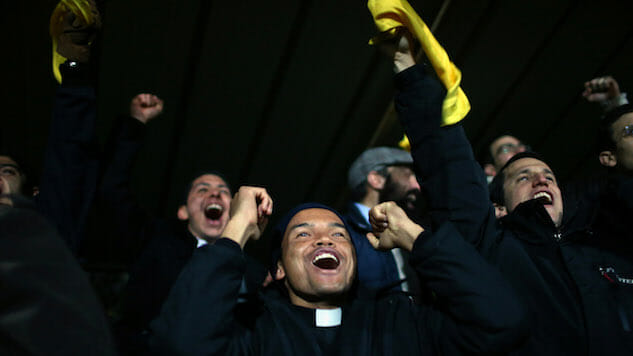Soccer in the Vatican: The Clericus Cup Turns 10
Photo by Christopher Furlong/Getty
Like the rest of the world, the Vatican loves soccer. And when you love a sport, you want to start a tournament or at least a pickup game. And so the Vatican founded a tournament featuring priests, seminarians, and players from the Vatican team (including the Swiss Guard!). If the success of the Clericus Cup’s first decade is any indication, the tournament will continue to grow:
@clericuscup hanno vinto loro #urbano 1-2 pic.twitter.com/xL9CCO2Lmy
— PCIMME (@pcimmeroma) May 23, 2015
The Cup is not the Vatican’s first foray into sports. Cardinals have been known to commentate for Italian soccer matches. Soccer teams regularly give the pope their jerseys. Pope John Paul II, who once played goalkeeper as a kid, created a Vatican department for sports. In 2007, the Vatican even bought an 80% stake in Italian soccer club AC Ancona. The interfaith equivalent of the Clericus Cup is the Vatican’s cricket team (appropriately nicknamed St. Peter’s Cricket Club), which travels for competitions against other faiths in Fatima and receives the Royal Household of Windsor in Rome. The “beautiful game” appears to be a universal language among Catholic priests. And soccer, particularly Clericus Cup soccer, definitely has a papal blessing:
As a tournament that priests and seminarians refer to as their World Cup, the Clericus Cup remains firmly rooted in the Vatican City and Rome. The hundreds of seminarians who participate each year come from dozens of countries, but there are no ‘away’ games—all the seminarians have a home in Rome. And it’s not just any home, but one with student-priests-gone-wild, chanting songs and wearing flags and country-specific costumes (Captain America, the Super Mario Brothers, et al.). There are even Star Wars-themed homage videos in which aspiring goalkeeper priests get kidnapped by the LA Galaxy, much to the chagrin of their Clericus Cup teams. (Thankfully, the LA Galaxy has never actually attempted to poach any player while he was competing for the Cup’s trophy of a hat-wearing soccer ball with cleats.)
The tradition of having soccer matches among the pontifical colleges in Rome is much older than the Clericus Cup, of course. Fr. Jim Mulligan started an eight-team tournament called the Rome Cup in 2003, when he was a seminarian at Pontifical Beda College. Among other teams, the North American Martyrs (unsurprisingly) have a history of trials and tribulations. None of that history, however, has impacted their successive Clericus Cup wins. Even the Martyrs have risen to soccer glory, dominating the 2012 and 2013 years.
Though not every player in the Cup is a priest, the hope is that the seminarians and priests on the teams will direct the play toward more lofty spiritual goals, and to help the personal growth of the friars in cleats. Previously, it was also partly to help restore decency to the game after the Calciopoli scandals and to convince world soccer organizations such as FIFA to adopt the so-called “sin cards.” For the Clericus Cup, these blue cards put a player in the “sin bin” for five minutes.
-

-

-

-

-

-

-

-

-

-

-

-

-

-

-

-

-

-

-

-

-

-

-

-

-

-

-

-

-

-

-

-

-

-

-

-

-

-

-

-








































